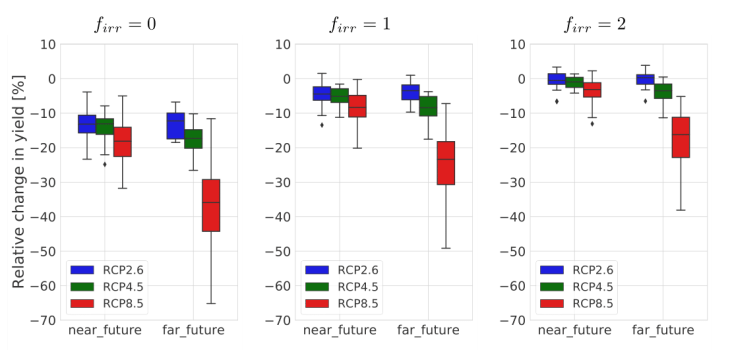Impact of irrigation on future yields using a statistical yield model
Using a statistical approach, we investigate climate change impacts in the agricultural sector in Northeast Lower Saxony. The statistical yield model might be interpreted as a sub-model of the system dynamics model involving climate variables, yield, and irrigation. Based three emission scenarios (RCP2.6, RCP4.5 and RCP8.5) we analyze different options of irrigation management as climate change adaptation. Specifically, we address the following questions:
1. How will potato yields be affected by climate change in Northeast Lower Saxony (NELS)?
2. To what extent can irrigation compensate possible future yield losses?
Fig. 4 shows future potato yield projections in NELS using the statistical regression model with feature selection. The projections include three climate mitigation scenarios (RCP2.6, RCP4.5, and RCP8.5) and three irrigation management scenarios (no irrigation, irrigation on today’s level, and double irrigation). The latter represent climate change adaptation scenarios. Without irrigation, potato yield losses for RCP2.6 and RCP4.5 are between 12.9% +/- 4.2% and 17.3% +/- 4.2%. In the climate scenario RCP8.5 without irrigation, potato yields decrease sharply by 36.6% +/- 12% until the end of the century. With irrigation remaining on today's level, potato yields decrease moderately in the near future and in the far feature for RCP2.6 and RCP4.5 (between 4.1% +/- 3% and 8.4% +/- 3.6%). They are 24.5% +/- 9.9% in the far future for RCP8.5. Hence, irrigation might compensate about 33.1% (24.5% loss instead of 36.6%) in the worst-case scenario. If today's level of irrigation is double, yield losses reduce. They range from 0.1% +/- 2.4% to 3.8% +/- 3.1% for RCP2.6 and RCP4.5 and increase to 17.7% +/- 8.4% for RCP8.5. Thus, doubling the amount of irrigation prevents 51.7% of the yield losses compared to the no-irrigation scenario. We find a very high model uncertainty, especially for RCP8.5. In the most extreme case, the yield losses are 56% on average. The presence of non-linear precipitation and temperature terms makes the model much more sensitive to small deviations.

Fig. 4: Relative change in potato yield in NELS compared to reference period (1978-2018) for different RCPs without irrigation (left), with irrigation remaining on today's level (middle) and with double irrigation (right). Near future refers to the average between 2035-2065 and far feature to the average between 2068-2098.

